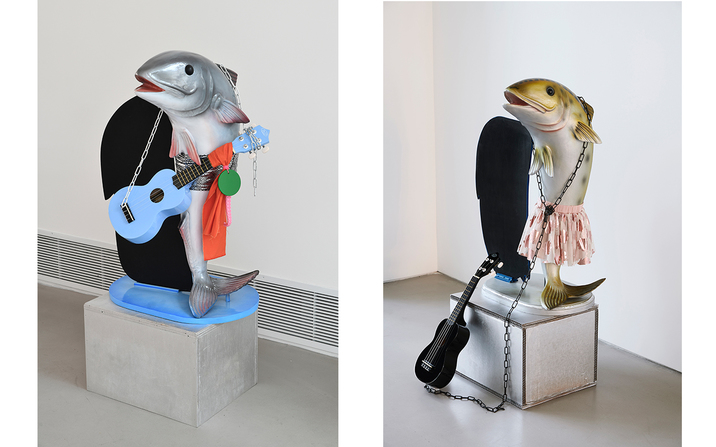-
From Current Issue
-
- Editor’s Letter Fire in the Heart
- Reviews I Gusti Ayu Kadek Murniasih
- Reviews 11th Seoul Mediacity Biennale: “One Escape at a Time”
- Dispatch Networked China
- One on One Monira Al Qadiri on Yukio Mishima
- Essays The rise of independent art spaces in pandemic-era Shanghai
- Features Tuan Andrew Nguyen
- Table of Contents
- Web Exclusives
- Archive
- Subscribe

R
E
V N
E
X
T
Installation view of COSIMA VON BONIN’s “Ocean and Caffeine” at Magasin III, Jaffa, 2019. All photos by Noam Preisman. Courtesy Magasin III.
Including seven works drawn from the past two decades of the artist’s career, Cosima von Bonin’s first solo show in Israel, “Ocean and Caffeine,” was concise yet representative. Although four of the exhibits were from Magasin III’s collection and must have been a given in constructing the show, the resulting constellation of works formed a focused reflection of the artist’s ongoing sea-themed explorations, granted a Middle Eastern air at Magasin III’s space in the port city of Jaffa.
Welcoming visitors to the exhibition were two plastic mackerels—the kind one might expect to hold up menus outside beach-side restaurants. Dressed with skirts and chained to ukuleles, What If It Barks 5 (Petite Version with Blue Ukulele) and 6 (Petite Version with Black Ukulele) (both 2018) bear a vaguely punkish, comical appeal. From the same series, What If It Barks 7 (Coffee Pot Version) (2018) features the light brown, ceramic vessel wrapped in variously patterned and colored fabrics. The tacky fish were sourced from the internet; the coffee pot accidentally arrived in the delivery and similarly “accessorized,” to use the artist’s term. Adorned with a black-and-white checked scarf recalling a traditional keffiyeh, the coffee pot seemed to be literally dressed up as an Arabic finjan.
Von Bonin hardly creates anything solely by herself, preferring cheeky ready-mades, commissioned pieces by craftsmen, or collaborations with fellow artists and musicians. Hermit Crab in Fake Royère & MVO’s Hermit Crab [Fake Royère] (2010) combines all three. Here, a stuffed hermit crab sits on a plush, blue garden armchair replicating a 1950s model by French designer Jean Royère. Von Bonin found the chair in an antique store in Cologne, her city of residence. The crab relaxes to a specially commissioned soundtrack by von Bonin’s longtime collaborator Moritz von Oswald, emanating from an overhead speaker. Seasons in the Abyss (2006) is another cuddly sea creature, this time a huge octopus with beautifully crafted glass prostheses protruding from several tentacles. These renderings of animals are often seen in relation to von Bonin’s proclaimed concerns regarding marine ecological crises, as if the anthropomorphizing of these creatures underscores their suffering, although this reading remains restrictive and narrow.
The centerpiece, Item (2001), is an impressive 11-meter long rowing boat, purchased from a boat manufacturer in Cologne, where rowing along the Rhine is a typical pastime. Jammed between the gallery’s two glass facades, with its seats sealed off, the boat is obsolete and misplaced. A long patchwork cloth made of found patterned textiles hangs nearby. One of the fabrics, which belonged to the artist’s grandmother, is emblazoned with the phrase “Waterloo – Belgium” and depictions of colonial generals carrying the French flag. The covering was originally used to dress and undress the boat in an odd, wake ceremony of sorts as part of von Bonin’s 2001 performance at Magasin III, Stockholm. Now, the cloth lies still, functioning as one of the artist’s typical “textile paintings,” or “rags” as she refers to them.
Another large-scale rag, titled Deprionen, A Voyage to the Sea (2006), features cartoonish sea creatures stitched with white threads onto Kikoys, a traditional African sarong that is now mass-produced and globally distributed by a company of the same name. Like the boat covering made with her grandmother’s cloth, the kikoy holds personal significance for the Kenyan-born artist. The two textile works are imbued with the suggestion of post-colonial critique, with their allusions to colonial wares and maritime trade routes opened by past empires.
Yet, facing these whimsical works, environmentalist or post-colonial readings seem heavy-handed and limiting. When asked to explain her art, von Bonin tellingly describes its production processes instead. As important as issues of ecology or cultural appropriation may be to the artist, her works reveal a naive playfulness that is at odds with didactic social commentary. Perhaps more compelling is how the works relate to von Bonin’s personal experiences, whether through creating soft toys of sea creatures she encountered as a child, or incorporating family heirlooms and objects characteristic of her hometown. Von Bonin’s art is arguably more poignant when viewed as a personal outpouring of her inner world. Nevertheless, it welcomes local and incidental associations, thus forming a desired space of aesthetic exchange between the artist and her viewer.
Cosima von Bonin’s “Ocean and Caffeine” is on view at Magasin III, Jaffa, until August 30, 2019.
To read more of ArtAsiaPacific’s articles, visit our Digital Library.

















